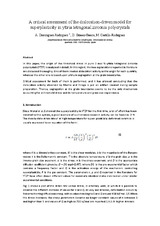Mostrar el registro sencillo del ítem
A critical assessment of the dislocation-driven model for superplasticity in yttria tetragonal zirconia polycrystals
| dc.contributor.author | Domínguez-Rodríguez, A. | |
| dc.contributor.author | Gómez García, Daniel | |
| dc.contributor.author | Castillo-Rodríguez, Miguel | |
| dc.date.accessioned | 2024-02-07T07:45:03Z | |
| dc.date.available | 2024-02-07T07:45:03Z | |
| dc.date.issued | 2008 | |
| dc.identifier.issn | 1873-619X | |
| dc.identifier.uri | http://hdl.handle.net/10396/27207 | |
| dc.description.abstract | In this paper, the origin of the threshold stress in pure 3 mol %-yttria tetragonal zirconia polycrystals (YTZP) is analysed in detail. At this regard, the two explanations reported in literature are discussed thoroughly. One of them invokes dislocation activity as the origin for such quantity, whereas the other one is based upon yttrium segregation at the grain boundaries. Critical assessment for both of them is performed, and it has allowed concluding that the dislocation activity observed by Morita and Hiraga is just an artifact created during sample preparation. Thence, segregation at the grain boundaries seems to be the only mechanism accounting for a threshold stress and its temperature and grain size dependence. | es_ES |
| dc.format.mimetype | application/pdf | es_ES |
| dc.language.iso | eng | es_ES |
| dc.publisher | The American Ceramic Society | es_ES |
| dc.rights | https://creativecommons.org/licenses/by-nc-nd/4.0/ | es_ES |
| dc.source | Journal of the European Ceramic Society, Vol 28, Issue 3, pp 571-575 (2008) | es_ES |
| dc.subject | Creep | es_ES |
| dc.subject | ZrO2 | es_ES |
| dc.subject | Threshold-stress | es_ES |
| dc.title | A critical assessment of the dislocation-driven model for superplasticity in yttria tetragonal zirconia polycrystals | es_ES |
| dc.type | info:eu-repo/semantics/article | es_ES |
| dc.relation.publisherversion | https://doi.org/10.1016/j.jeurceramsoc.2007.08.002 | es_ES |
| dc.relation.projectID | Gobierno de España. MAT2003-04199-C02-02 | es_ES |
| dc.relation.projectID | Gobierno de España. MAT2006-10249-C02-02 | es_ES |
| dc.rights.accessRights | info:eu-repo/semantics/openAccess | es_ES |

